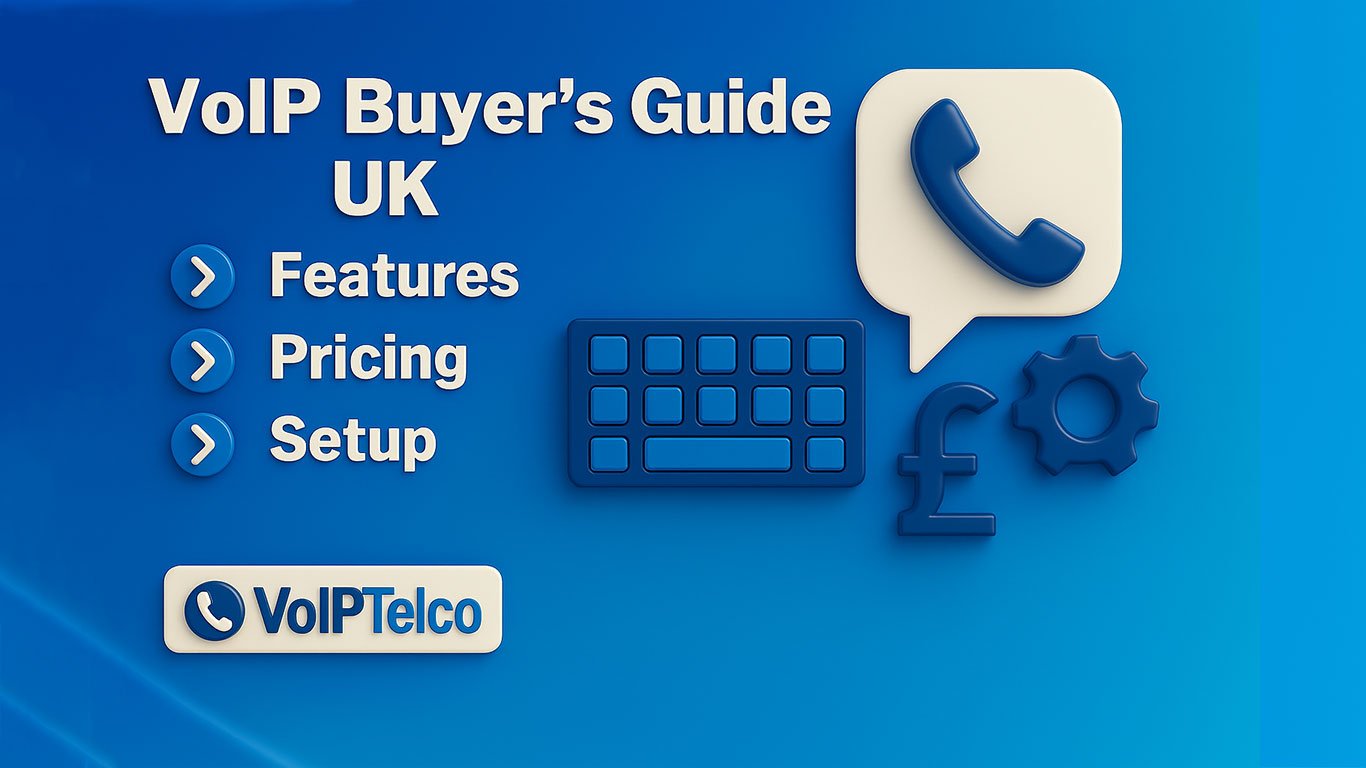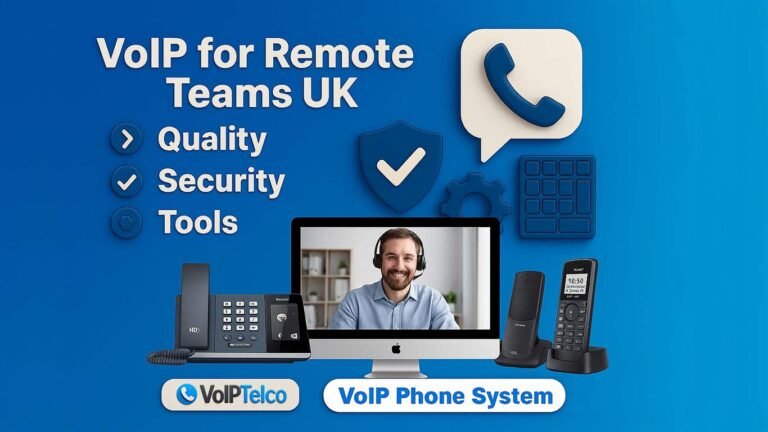VoIP Buyer’s Guide UK: Features, Pricing, Setup

Plan your move to cloud calling with confidence. What to look for, how much to budget, and the setup steps that keep UK projects on time.
PSTN retires Jan 2027
Keep your numbers
IVR, Queues, Recording
Teams & CRM apps
TLS/SRTP security
999 access plan
Why VoIP — and why now?
The UK’s analogue network is being retired by January 2027, so internet-based calling is the sensible default. Modern VoIP gives you flexible routing, integrations, and reliable quality for onsite and remote teams — without the cost and hassle of on-prem PBX hardware.
Key VoIP features to prioritise
Call handling & routing
Auto-attendant/IVR, ring groups, hunt lists, call queues with estimated wait and callback. Route by hours, skills, or caller intent.
Productivity & mobility
Softphone & mobile apps, hot-desking, visual voicemail, voicemail-to-email, presence and click-to-dial.
Integrations
Microsoft Teams calling, CRM screen-pops (HubSpot, Salesforce, Zoho), calendars/contacts, webhooks.
Compliance & analytics
On-demand or policy-based recording, retention controls, MOS/jitter/loss quality analytics, role-based access.
Reliability & security
Geo-redundant cloud, SBCs, DDoS/toll-fraud protection, encryption in transit (TLS/SRTP), failover rules to mobiles.
Emergency calling
999/112 access with location handling and a power-cut plan for at-risk users (e.g., battery backup).
How much does VoIP cost in the UK?
Most SMEs pay £8–£20 user/month for essentials and £25–£35 with advanced analytics, recording, or international bundles. Hardware, connectivity and setup/porting are separate line items.
| Plan tier | Typical features | Guide price (ex-VAT) |
|---|---|---|
| Essential | Softphone/mobile apps, IVR, ring groups | £8–£15 user/mo |
| Professional | Queues, analytics, CRM/Teams integration | £15–£25 user/mo |
| Compliance | Always-on recording, advanced reporting | £25–£35 user/mo |
Tip: many organisations go 70–80% softphone and keep a few shared desk phones for reception/meeting rooms to minimise capex.
Network readiness: hit great call quality
- Bandwidth: ~100 kbps per active G.711 call each way.
- Latency: keep one-way under ~150 ms for natural conversation.
- Jitter & loss: minimise jitter and keep packet loss near zero.
- QoS & VLANs: mark voice with DSCP; prioritise at switches/routers.
- LAN health: avoid power-saving on ports; correct duplex/speed.
- Security: TLS/SRTP, SBCs, IP allow-lists, fraud alerts.
- Failover: fibre + 4G/5G backup, or forwarding rules to mobiles.
UK compliance essentials
Ensure 999/112 access and a documented approach for power cuts. At-risk users should have a minimum one-hour solution (e.g., battery backup) and clear guidance.
Keep your existing numbers on reasonable terms. Plan staged porting windows and gather clean LOAs/bills to avoid delays.
Choose a lawful basis (often legitimate interests or consent), inform callers, secure recordings (encryption/role-based access), and set retention periods. Update your privacy notice and train staff.
Migration plan
1. Discovery
Inventory numbers/devices, map call flows, assess connectivity/QoS, and define target architecture.
2. Design
Codecs, IVR/queues, security (TLS/SRTP, SBCs), 999 location handling, GDPR recording policy.
3. Build & Pilot
Configure tenant/SBC, pilot with a champion team, tune QoS, train users and supervisors.
4. Port & Optimise
Stage porting, monitor closely at go-live, iterate IVR/queues and analytics, and test resilience periodically.
RFP & vendor comparison checklist
- Architecture & uptime: geo-redundancy, SBC regions, last-12-months availability.
- Quality & security: codecs (G.711/Opus), TLS/SRTP by default, DDoS/toll-fraud controls.
- Compliance: 999/112 location handling, power-cut plan, recording security & retention.
- Commercials: tier inclusions, fair-use policy, out-of-bundle rates, porting fees & ETAs.
- Support: SLAs (response/restore), UK support hours, named TAM during migration.
Common pitfalls to avoid
- Skipping network/QoS planning — voice competes with everything else.
- Big-bang number porting — stage it and protect key lines.
- Recording without GDPR processes — lawful basis, disclosure, retention.
- No power-cut scenario for at-risk users — document and test.
- Buying features you won’t use — start lean, expand later.
VoIP FAQs (UK)
Your 30-day action plan
- Audit numbers, devices, and call flows.
- Check network readiness (latency, QoS, Wi-Fi).
- Shortlist 2–3 providers with line-item quotes.
- Pilot with one team; fix QoS gaps.
- Schedule staged porting (critical lines last).
- Confirm 999/112 plan and GDPR posture in writing.
Ready to plan your VoIP migration?
Tell us your team size, locations, and current setup — we’ll map a realistic budget and timeline you can take to stakeholders.






